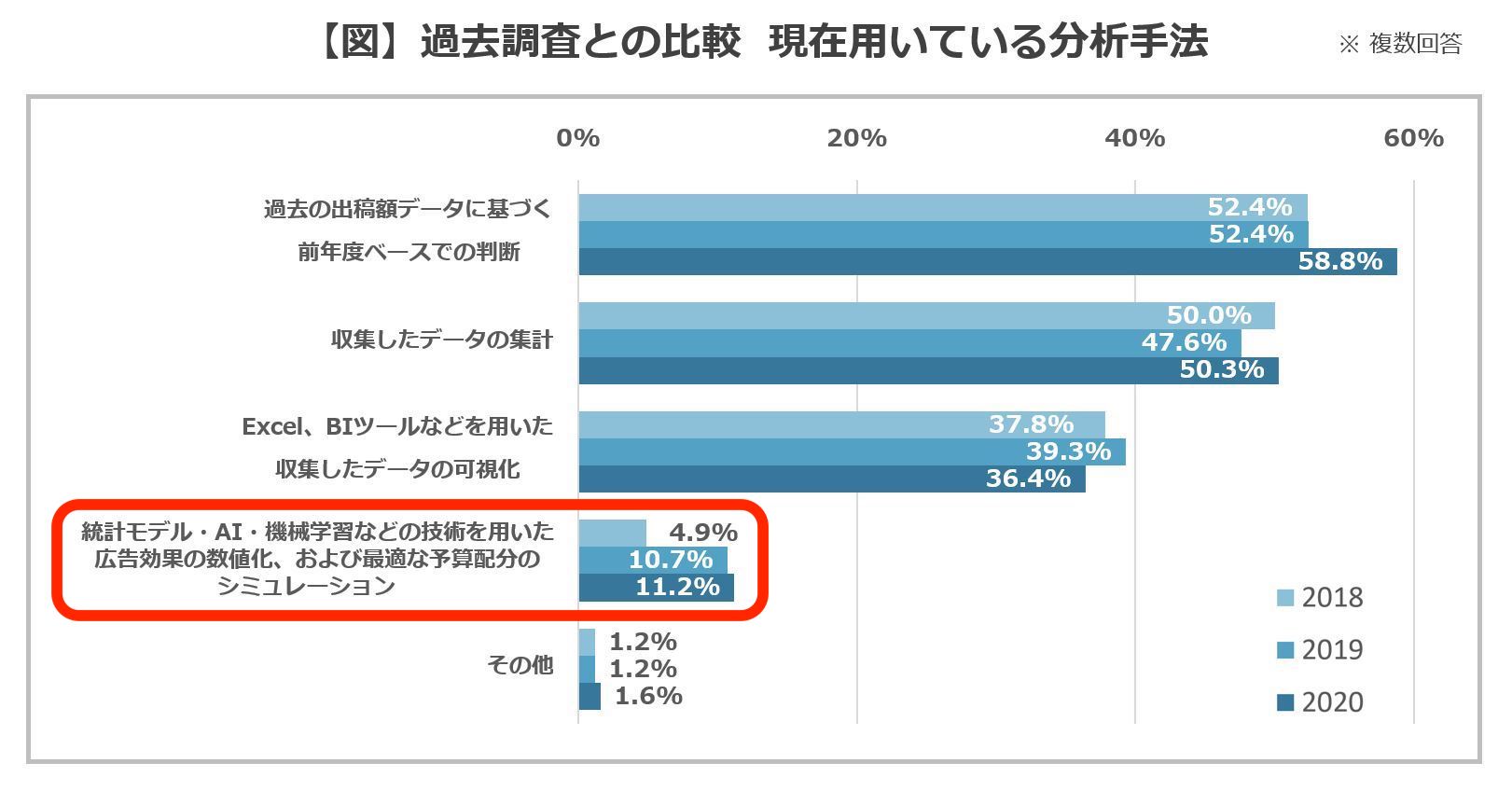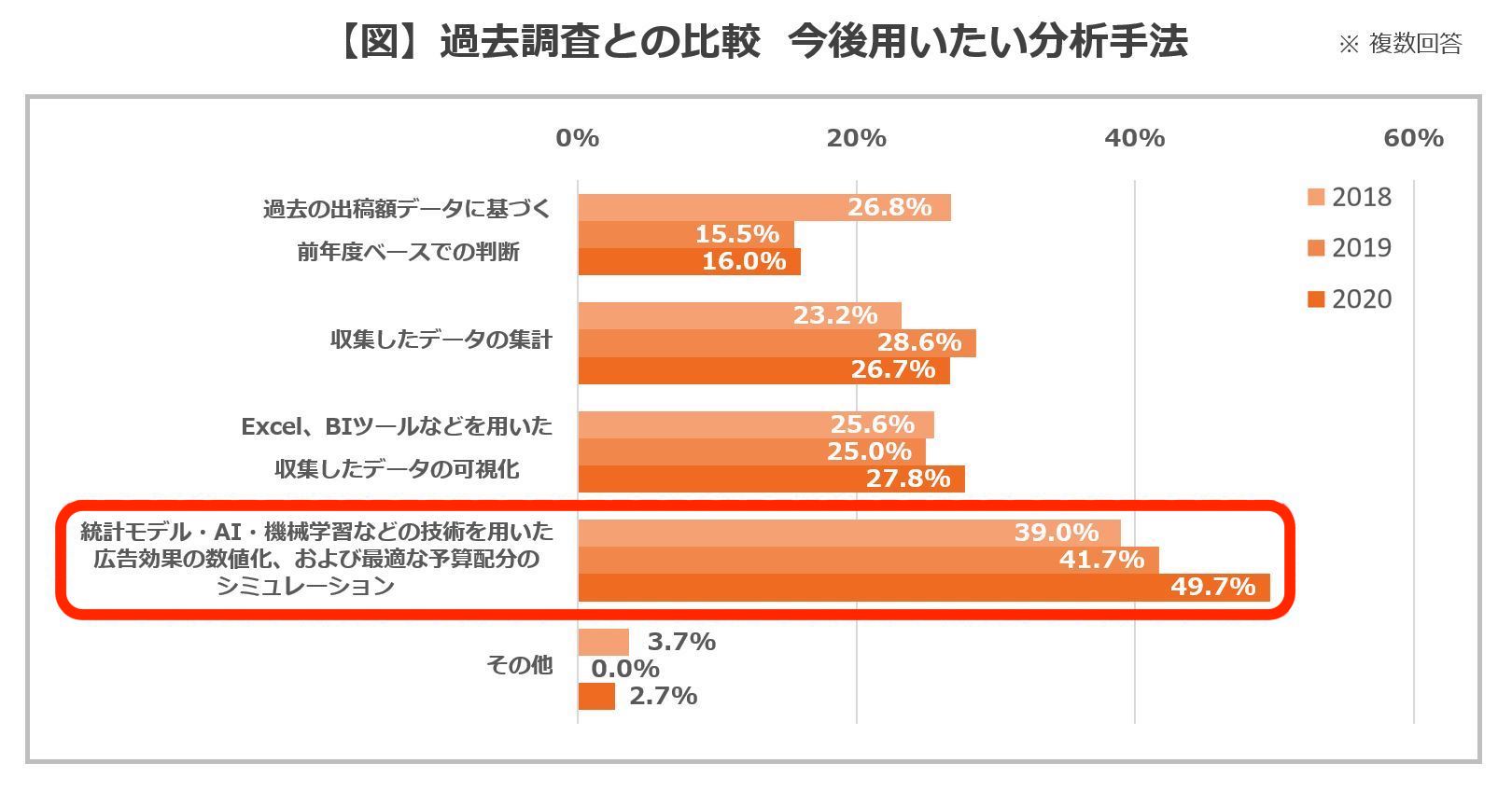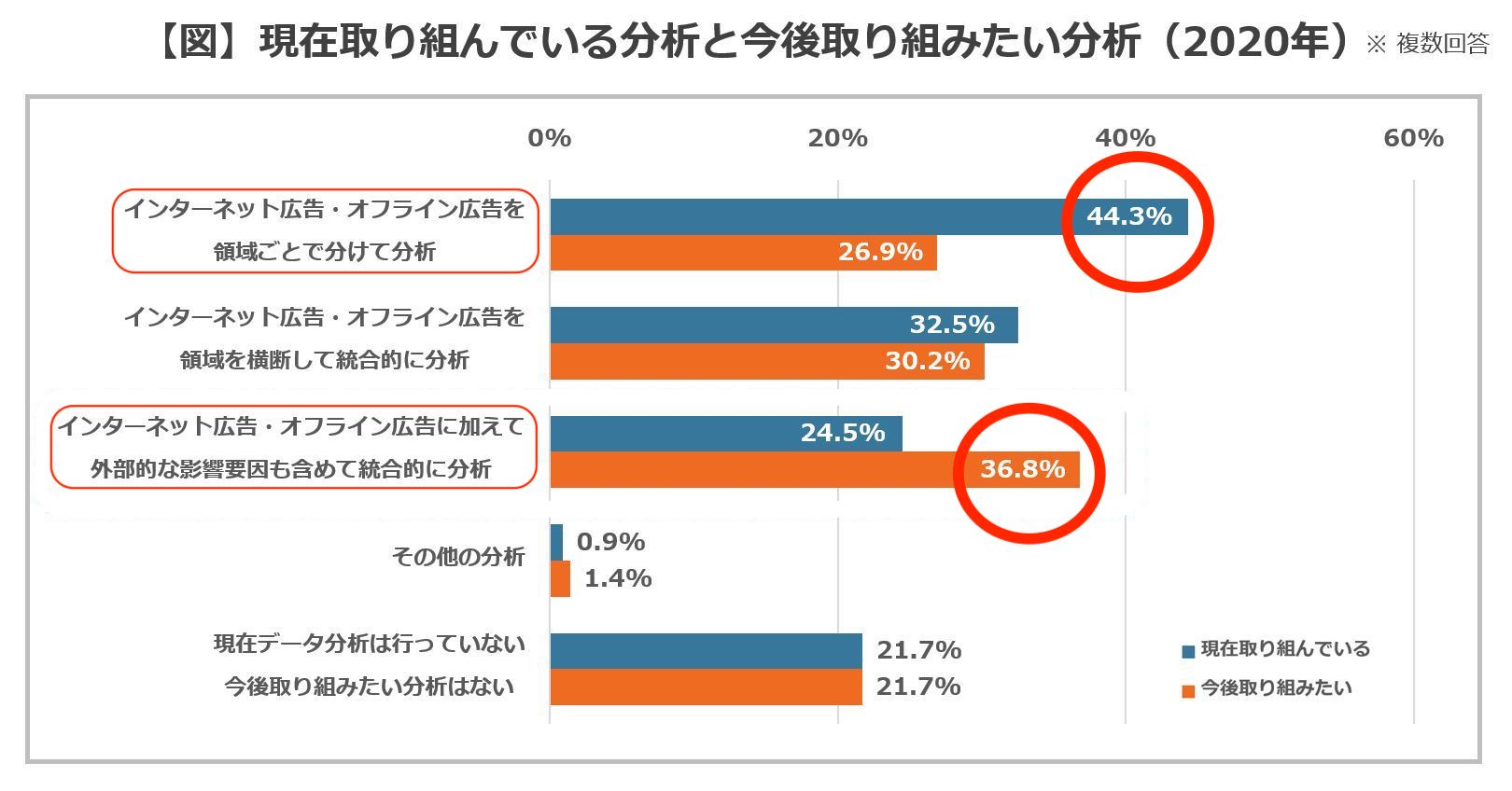Three reasons why Japan should incorporate MMM into marketing in the cookieless era

In the United States, a country with a strong marketing leadership, about 8% of marketers are aware of the marketing analysis method "Marketing Mix Modeling (MMM)" and about half of companies are using it (*1). In Japan, only 1% of companies have adopted MMM (*2), but in fact, in many ways, it can be said to be the optimal analysis method for the modern marketing environment.
In this article, we will explain the differences between MTA and MMM, which are mainstream in Japan, and why MMM is ideal for next-generation marketing.
(*1) Announcement of the publication of the latest report by the consortium of Nielsen Media, Facebook and Google, "How to Improve Advertising Performance with Marketing Mix Modeling" (Nielsen Media Japan LLC press release)https://prtimes.jp/main/html/rd/p/000000004.000070691.html
(*2) 212 edition of a survey of 2020 corporate advertising managers on how to measure advertising effectiveness (XICA Co., Ltd. press release)https://www.atpress.ne.jp/news/213842
table of contents
- MMM is an effectiveness measurement method suited to the modern marketing environment
- The rate of MMM use among Japanese companies is about 1%.
- MTA is highly regarded in Japan, and MMM is highly regarded worldwide
- The advent of the "cookieless era" accelerates the adoption of MMM in Japan
- Three ways to practice MMM in Japan
MMM is an effectiveness measurement method suited to the modern marketing environment
Modern marketers are required to develop marketing communications that combine a wide range of media and channels. In order to maximize results in such a complex environment, it is not enough to correctly understand the effectiveness of each measure,Maximize synergy between measuresneed to do it.
Marketing Mix Modeling (MMM) was born in the United States in the 70s, more than 1950 years ago. It was developed with the aim of visualizing the impact that offline marketing measures such as television commercials, radio ads, transit ads, and newspaper ads have on sales.
Modern MMM has evolved from there.A method of measuring effectiveness that can quantify the impact of various marketing measures on results, both online and offlineSince it analyzes all marketing measures in an integrated manner, it is also called "integrated attribution analysis(*3)."
(*3) Attribution analysis: Analysis that quantitatively measures the contribution of each marketing initiative to results (sales).
There are three reasons why MMM is suited to the modern marketing environment.
The first is the marketing strategy"You can quantify both the impact on results (direct effect) and the impact on other marketing measures (indirect effect).こと.
The 2 one isYou can also analyze external factors that you cannot control.It is that.
External factors refer to any factor that may affect the effectiveness of marketing initiatives or business performance, such as the market environment (such as competitors' advertising and sales strategies), seasonality, and weather.
Even if your marketing strategies are perfect, your sales will fall if your competitors implement major price cuts, and the number of customers will decrease if a typhoon comes. In recent years, the impact of COVID-19 has had a major impact on sales, regardless of the success or failure of your marketing strategies.
Conversely, there are cases where sales increase due to external factors even if a company's own marketing strategies are not successful.
The third is brand equity (the value of a brand that increases the value of a product or service).The results of mid- to long-term measures spanning several months to several years can be broken down into short-term marketing measures.It is that.
Although this is an applied approach, brand power is the basis of marketing results. How well known is your company or service? Do people have a good impression of it? And how much does it affect results? By visualizing these things, the measures you need to take should change.
In this way, MMM comprehensively grasps all factors such as the synergistic effects between measures, the influence of external factors, and brand value, which have previously been considered difficult to visualize, andQuantifying the "true effect of marketing measures"To do.
Even in today's world where marketing strategies have become more diverse and complex,MMM provides hints on how to optimize advertising budgets for overall optimization rather than individual optimization and maximize marketing results.
The rate of MMM use among Japanese companies is about 1%.
MMM is widely used in the United States, the country where it originated and a leading marketing nation, regardless of the size or industry of the company. On the other hand, in Japan, advanced analysis like MMM is not yet widely used.
A survey conducted by XICA in April 2020,Survey of 212 corporate advertising managers on how to measure advertising effectiveness, 2020 edition"But it became clear.
When we asked advertising and promotion personnel about the analysis methods they currently use and the ones they would like to use in the future,Only 11.2% of companies responded that they are currently using "quantification of advertising effectiveness using technologies such as statistical models, AI, and machine learning, and simulation of optimal budget allocation."Compared to past surveys, the figure was 2018% in 4.9 and 2019% in 10.7, and although this is an increasing trend, the number of companies that have introduced the system nationwide is still not large.
on the other hand,Nearly half (49.7%) of companies responded that they would like to use "quantification of advertising effectiveness using technologies such as statistical models, AI, and machine learning, and simulation of optimal budget allocation" in the future.This is the third consecutive year of increase since the 2018 survey, and the need for advanced analytical methods is on the rise.


The survey also investigated the extent to which cross-disciplinary analysis that integrates online measures, offline measures, external factors, etc. is being implemented.
When asked what kind of analysis they are currently undertaking, 44.3% chose "analysis of online advertising and offline advertising by area," while when asked what kind of analysis they would like to undertake in the future, 36.8% chose "comprehensive analysis that includes external influencing factors in addition to online advertising and offline advertising."
These results show that Japanese companies have a high level of interest in advanced, cross-disciplinary analytical methods such as MMM.High demand, but not enough to put into practiceseems to be the current situation.

MTA is highly regarded in Japan, and MMM is highly regarded worldwide
In Japan, where only about 1% of companies use MMM, the currently mainstream analysis method is "multi-touch attribution (MTA)."
MTA measures the impact of digital advertising on business results such as sales based on individual behavioral log data such as cookies.
MTA and MMM are similar in that they are methods of analyzing past data to calculate the sales contribution and ROI of campaigns and consider optimizing advertising budgets, but the data they use as the basis for their analysis is different.MTA is contact data for each touch pointBased on the above,MMM is a time-series correlation of factors that are thought to affect sales.Based on the above.
MTA allows for highly accurate analysis in the case of e-commerce businesses where both marketing and sales are completed online. On the other hand, for businesses that combine online and offline initiatives, it is difficult to obtain individual behavioral data for offline initiatives, making detailed analysis difficult using MTA alone.
So, which is the more suitable analysis method for modern marketing: MTA or MMM?
According to a survey on the history and latest trends of marketing effectiveness measurement in the United States conducted by XICA, since 2016,Measuring and optimizing marketing through integrated analysis combining MTA and MMM is the key to differentiating companiesIt was found that the following was true (*4).
Analytic Partners, a US-based company that provides marketing effectiveness measurement and optimization services and consulting that combine MMM and MTA, announced in November 2019 that"80% of the incremental value of the optimization tips we provide to our clients comes from MMM insights, with MTA contributing only the remaining 20%."The company announced the results of its survey(*5).
MMM, which clarifies the relationships between measures and the linkages between measures over time, is likely to provide more insight into optimizing overall marketing than MTA, which excels at measuring the effectiveness of each touchpoint.
In the United States, an increasing number of companies have established in-house specialized teams to put MMM into practice, and businesses that provide MMM tools. This also shows that MMM has been recognized as an effective analysis method and is rapidly gaining in popularity.
(*4)See the following URL:
・Market Guide for Attribution and Marketing Mix Modeling (Gartner, Inc.)https://www.gartner.com/en/documents/3463318/market-guide-for-attribution-and-marketing-mix-modeling
・The Forrester Wave™: Marketing Measurement And Optimization Solutions, Q1 2020 (Forrester)https://www.forrester.com/report/The-Forrester-Wave-Marketing-Measurement-And-Optimization-Solutions-Q1-2020/RES145975
・The Forrester Wave: Marketing Measurement and Optimization Solutions, 2016 (Forrester)https://www.forrester.com/blogs/16-10-12-the_forrester_wave_marketing_measurement_and_optimization_solutions_2016/
(*5)Disrupting MTA: Introducing Commercial Mix Modeling (Analytic Partners)https://analyticpartners.com/news-blog/2019/11/disrupt-mta-commercial-mix/
The advent of the "cookieless era" accelerates the adoption of MMM in Japan
The introduction of MMM has been slow in Japan for several reasons.The introduction of this technology will progress in Japan in the future.The biggest reason is thatThe trend towards stronger data regulations and privacy protection is accelerating globallyThere is a particular thing.
In addition to the European Union's General Data Protection Regulation (GDPR) (enacted in 2018) and California's California Consumer Privacy Act (CCPA) (enacted in 2020), which have seen various countries and regions working on data privacy initiatives, there has been an increase in the movement to protect data privacy in recent years, such as Apple's restriction on the acquisition of advertising identifiers (IDFA) announced in conjunction with the release of the iOS 2021 beta in spring 14.5, and the abolition of third-party cookies in various web browsers including Google Chrome.
This means that the amount, variety, granularity and use of customer data that can be obtained online is severely limited.It is likely that it will become technically difficult to ensure the accuracy of MTA, which performs analysis based on individual behavioral data.
MMM does not conduct real-time analysis based on individual behavioral data using cookies, etc. The data used in the analysis is advertising volume (GRP for TV commercials, number of impressions and clicks for digital ads, etc.), costs, results (number of store visitors, sales, number of applications, number of contracts, and other conversion numbers), and data on external factors such as market environment, seasonality, and weather.
in this way,MMM is a method to accurately and continuously measure marketing activities even in the cookie-less era
Three ways to practice MMM in Japan
There is already a high potential demand for MMM among Japanese companies, and it is expected that demand will continue to grow in the future. There are three main ways to put it into practice. Below, we will introduce each method along with its advantages and disadvantages.
1. Ask a research or consulting company to analyze the data
- Advantages: Data analysis can be carefully adjusted by professional data scientists. There are a relatively large number of providers, so there are many options for services.
- Disadvantages: High cost/It takes 3 to 6 months to get the analysis results
2. Hire your own data scientists
- Advantages: Since the analysis is conducted after understanding the company's issues, it is easy to link the analysis results to the next action.
- Disadvantages: It is very difficult to recruit data scientists, so it often takes a lot of money to recruit them. There are few data scientists in the job market.
3. Use tools that can perform MMM analysis
- Advantages: Analysis can be done in a short time without specialized knowledge / Cheaper than outsourcing to a research or consulting company
- Disadvantages: There are few MMM analysis tools available in Japan, so there are few options
The table below compares these methods based on four points: "Ease of linking to the next action (problem awareness and accuracy of hypothesis)," "Time required for analysis," "Cost required for analysis," and "Number of options."

In modern and next-generation marketing, data analysis to correctly evaluate the contribution of each measure to sales and the synergistic effects between measures is now essential.
In order to avoid wasting limited resources and achieve maximum results with appropriate investment, it is important to select or combine effectiveness measurement methods that suit the characteristics of your company's business and marketing strategy.
Taking into account social trends such as strengthening data protection and privacy regulations, why not reconsider and discuss the future direction of your company's marketing effectiveness measurement?
Recommended articles
-
 Column
ColumnWhere data and intuition intersect in marketing strategy: How to improve the quality and speed of your decisions
-
 Column
ColumnTurning environmental change into your ally: Marketing strategies to win in the market
-
 Column
ColumnThe first step towards a data-driven marketing organization: A practical approach
